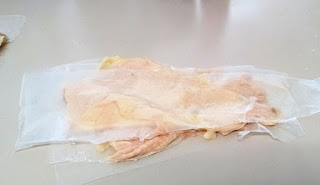Master
Indy issued another challenge to slave this weekend:
“Cook
me something sweet but not fattening!” Well
this chicken dish does have a sweet sticky finish on it. The calories
are limited. This should satisfy His sweet tooth and still be
healthy! Just keep the sides plain to compliment the main food. For
instance here slave serves quinoa and fresh roasted green beans. Each
adds its own enhancements to the featured event.
Again,
since we live in a time of high poultry prices, notice how much we
can save by not buying the the bone-less, skin-less chicken. Leave
the bone in and remove the skin ourselves. When you remove the skin,
you remove a whole bunch of the fat. Bag the skin and freeze it. You
can substitute this for bacon at times.
Ingredients
- 5 teaspoons olive oil
- 5 bone-in chicken thighs (about 1-3/4 pounds), skin removed
- 1/3 cup water
- 1/4 cup packed brown sugar
- 2 tablespoons orange juice
- 2 tablespoons reduced-sodium soy sauce
- 2 tablespoons ketchup
- 1 tablespoon white vinegar
- 4 garlic cloves, minced
- ¼ teaspoon crushed red pepper flakes
- 2 teaspoons cornstarch
- 2 tablespoons cold water
- Sliced green onions
- Hot
cooked quinoa, optional
Directions
First do your cutting: mince the garlic. Then lay out the chicken on a sheet of wax paper. Then skin should just peel off, you might need a sharp knife to separate the fat but for the most part, just pull!I cut the wax paper around the laid out pieces of skin. Sprinkle some salt and seal that up to freeze.
- In a large skillet, heat oil over medium heat. Add chicken; cook 8-10 minutes on each side or until golden brown. The chicken will release from the pan when it is ready to turn.In a small bowl, whisk water, brown sugar, orange juice, soy sauce, ketchup, vinegar, garlic, and pepper flakes.
- Pour over chicken. Bring to a boil. Reduce heat; simmer, uncovered, 30-35 minutes or until chicken is tender, turning chicken at the 15 minute mark.
You
will notice that since most people only use the right front burner,
slave spreads the duties around.
The
fresh green beans have been snapped and soaked:
Now
is the time to slide that foil lined tray with the beans into the
oven at 400 degrees for 30 minutes.
- In a small bowl, mix cornstarch and cold water until smooth; stir into pan. Bring to a boil; cook and stir 1 minute or until sauce is thickened. Sprinkle with green onions.
For our music:
To
satisfy and restore.
To
nourish, support and maintain.
To
gratify, spoil, comfort and please,
to
nurture, assist, and sustain
…..I
cook!
Please
buy slave's cookbook:
October
is LGBT History month:
Much
of the quotes for this piece were from contemporary writings nearly
400 years old and may be difficult to read. This was before
standardized spelling came to the New World.
1624
Richard
Cornish, alias Richard Williams (d. after January 3, 1625)
Cornish
was master of the merchant ship Ambrose in 1624 and the following
year was tried, condemned, and hanged for forcibly sodomizing William
Couse, a nineteen-year-old member of the crew. Apart from the name of
Cornish's brother and the controversial aftermath of the trial,
nothing else is known about him.
On November 30, 1624, Couse
testified before the Governor's Council that on the afternoon of
August 27, 1624: "Richard Williams als Cornushe" had
forcibly sodomized him aboard the ship, then riding at anchor in the
James River, and caused him "payne(sp) in the fundament"(sp)
that left him "sore 3 or 4 dyes."(sp) He also reported
that Cornish had apologized but later put his hands inside Couse's
codpiece "many tymes (sp) … and plaid and kiste him."
The testimony indicated that on one occasion when Cornish called
Couse to him but Couse refused to go, Cornish stood him "before
the maste (sp) and forbad all the shipps(sp) Company to eate(sp)
with him" and made him "Cooke (sp) for all the rest."
On
January 3, 1625, Walter Mathew, the boatswain's mate on the Ambrose,
testified that he had overheard part of a conversation between
Cornish and Couse when the two were in the master's locked cabin.
When Mathew later questioned Couse about what had taken place, Couse
"replied he would keepe (sp) that to himself till he cam (sp)
into England." He later told Mathew only that Cornish "would
have Bugard (sp) him" but refused to state whether the captain
"did the fact."
Perhaps
this might have been a consensual relationship, but a ship's master
had considerable authority over a cabin boy, and Couse may have had
few means of effective resistance. His comment to Mathew about not
mentioning what Cornish had done until they returned to England hints
that Couse may have intended to lodge a complaint with the English
authorities. The two depositions of Couse and Mathew are all that
survive in the Council's fragmentary records that predate Cornish's
trial and execution.
Cornish
was convicted and executed on an unrecorded date, probably not long
after Mathew's testimony on January 3, 1625
Several
mariners and Virginia residents later asserted that Cornish, an
excellent mariner, had been unjustly hanged, and they blamed the
governor, Sir Francis Wyatt. Criticism of the trial reverberated
throughout the maritime community for more than a year. During the
winter of 1625–1626, the Council heard testimony from several
mariners indicating that Richard Cornish "was hangd (sp) for a
rascally boye (sp) wrongfully," and Arthur Aveling testified
that Cornish was executed "through a scurvie (sp) boys
meanes,(sp) & no other came against him."
It
should be noted that the Captain was hanged not for the
“relationship” which was often overlooked, but rather for the
“rape”!
Be
sure to read slave's full article in all four parts in “the Vital
Voice”:













Terimakasih atas informasinya,i Like and goodluck..
ReplyDeleteThank You So Much!
ReplyDelete